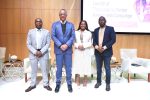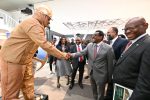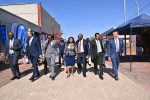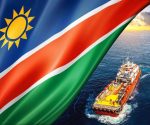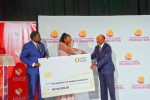Namibia’s position as a central hub for mineral development in Southern Africa was underscored today as the 12th Mining Expo & Conference opened its doors, attracting a significant contingent of 21 companies from across the Southern African Development Community (SADC) region. This strong regional turnout, alongside four international exhibitors and a dominant Namibian presence, highlights the growing importance of the event and Namibia’s mining sector within the broader African context.
Chamber of Mines of Namibia President, George Botshiwe, announced the impressive regional participation during his welcome address at the Windhoek Showgrounds, marking the commencement of the largest Expo in its history. A record-breaking 198 exhibitors have filled 335 booths, necessitating the event’s extension to three full days for the first time ever. The presence of these 21 SADC companies signifies deepening regional collaboration and a shared interest in Namibia’s mineral potential and investment landscape.
“Alongside a strong contingent of Namibian companies, we are proud to welcome 21 companies from the SADC region,” President Botshiwe declared before an audience that included Namibian President Dr. Netumbo Nandi-Ndaitwah, cabinet ministers, diplomats, and industry leaders. He emphasized that this diverse participation “underscores the regional and global significance of Namibia’s mining industry.”
The Expo, organized by the Chamber of Mines, maintains its core objectives: showcasing Namibia’s mining industry to stakeholders and citizens; creating a platform for local business development within the mining supply chain; and promoting careers in mining, particularly among youth. Free entry for individuals, funded by exhibitors and sponsors, ensures broad accessibility, making it “truly Namibian, for Namibians.”
This year’s conference theme, “Mining for Namibia’s Future: Job Creation, Local Empowerment, and Economic Transformation,” resonates strongly with regional neighbours. Discussions tomorrow will spotlight developments in uranium and emerging gold sectors, value addition, employment creation, supply chain empowerment, and the sector’s legacy projects since independence – topics highly relevant across SADC.
President Botshiwe acknowledged challenges, particularly the 1.2% contraction in the mining sector during 2024, driven largely by pressures on the diamond industry from lab-grown alternatives and global economic headwinds. However, he firmly positioned mining as Namibia’s economic bedrock, contributing a dominant 13.3% to GDP and demonstrating resilience by creating approximately 2,600 new jobs last year.
The regional participants witnessed Botshiwe highlight the sector’s massive indirect impact through local procurement. Mining companies spent N$23.94 billion with Namibian businesses in 2024 alone, representing 46.2% of industry revenue and 62% of total procurement. Furthermore, the sector’s contribution to government coffers since 2019 stands at a substantial N$31.463 billion from royalties, taxes, levies, and dividends.
Botshiwe also pointed to robust investor confidence, evidenced by Namibia’s ranking as Africa’s fourth most attractive mining investment destination in the 2024 Fraser Institute Survey. He cited advancing projects like the Etango-8 and Tumas uranium developments and the Twin Hills gold project as tangible proof of the sector’s promising future trajectory, offering potential lessons and opportunities for SADC partners.
The Chamber maintained its tradition of complimentary booths for key institutions, including several ministries, universities (UNAM and NUST), industry associations like the Namibian Uranium Association, NIMT, SAIMM Namibia, EMAN, and WiMAN. Sponsors, particularly anchor sponsor RMB, were acknowledged for their crucial support in enhancing the Expo experience with facilities like the B2B platform, Supplier’s Platform, and dedicated app.
The significant participation from the SADC region adds a vital dimension to this record-breaking Expo, fostering cross-border dialogue and partnership opportunities. It reinforces the event’s status as a premier platform not just for Namibia, but for the wider Southern African mining community, as they collectively navigate challenges and pursue opportunities for sustainable mineral-driven development.
